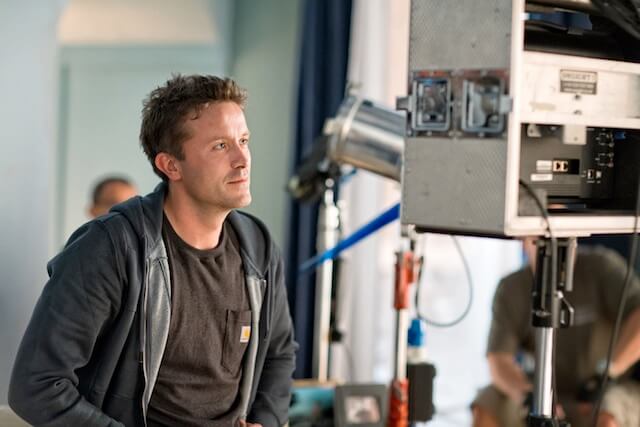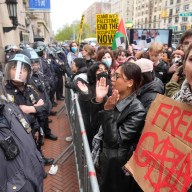Stevan Riley says when he started on the doc “Listen to Me Marlon” he only knew the traditional line on its subject, Marlon Brando: that he was an unhinged, eccentric recluse who spent the back off his career wasting his copious talents. He found a decidedly different version once he made the film’s major discovery: a series of audiotapes the actor had made in his latter decades, in which he reflected on his past, on acting, on his sometimes mocked political activism. As such, “Listen to Me Marlon” offers an alternate view of a figure on whom almost everyone has a misinformed opinion, and does it without resorting to talking heads — or, really, anyone but Brando speaking. There have been a handful of docs about artists recently — “Montage of Heck,” “Amy,” this — that eschew traditional talking heads almost entirely.
I certainly relish the chance to get away from the talking heads. That doesn’t ever feel that creative. Unless it’s important to see their face on screen, I question that — Why am I looking at this person? When you see talking heads you might think, Why am I in a cinema? Why isn’t this just on TV? RELATED: Review: “Listen to Me Marlon” tells Marlon Brando’s story in his own words It shows that there are there can be a lot of creativity and formalism when it comes to making documentaries, which most viewers might not think is possible.
It always feels like you’ve got your work cut out when you’ve got a real life story, as opposed to fiction, because it’s hard to elevate. It does give you a more interesting couple of years, though. But it’s terrifying. Other documentaries, they go out and do interviews, which is great because you can plug gaps in the story. But it’s quite scary when you’re doing it entirely in the voice of one person. Brando’s sort of private and those tapes weren’t initially available. When I made the pitch to do it all in Brando’s own words, I only had a handful of tapes, in the hopes that more would come out. Thankfully more did. The more I investigated, the more persuaded I was to stick to the original plan, because Brando just got more complex. The more people I met and the more books I read, the more shadowy he became. It was nice to have the confidence in this approach, but it was scary because how do you tell a layered narrative when there’s no guarantee the entire story is in there? This argues against a lot of assumptions and myths about Brando, including that he was out of his mind. He was definitely eccentric but the film shows a method to it.
He was a perfectionist. When he committed to something he cared about the work. But on the flip side — and this could happen on the same day — he could switch between optimism and pessimism, over how Hollywood treated him, how film would take a left turn from how he thought the script would be, the glare of the media spotlight. There were money issues that made him disillusioned and turned him into a cynic. He even had a basic lack of faith in human nature. He started off as this idealist who felt we could best serve our fellow man by working towards a new society, which is what he wanted to demonstrate in “Mutiny on the Bounty.” Then he reached a point where he thought we’re all essentially violent and aggressive. It’s part of our atavistic nature. It’s going to take millennia or untold evolutionary cycles for us to escape this trap. You caught him at the wrong time of day he was nihilistic and pessimistic beyond all belief. But there was always hope. The film also sympathizes with some of his controversial political work. The Sacheen Littlefeather incident is often portrayed negatively or as a joke.
You could say that he was trying to get some publicity for himself, which you know is anathema to him. He did everything in his power to not do that. Soon as you discount that you’re left with the proposition that he thought it was an issue Hollywood needed to address. Brando sensitively remarked that it was the mark of a civilized society to be able to look back on its past with honesty, rather than brush it under the carpet. There’s a quote from Churchill: “America will always do the right thing — after they’ve exhausted all the alternatives.” I think he was patriotic in terms of what he thought Americans should stand for. But he saw a lot of hypocrisy. In the audiotapes, Brando talks a lot about exploring humankind’s dark side by playing villainous or unlikable characters.
He was trying to see how close you can come to violence. You just don’t know what you could do at a certain moment. He knew we could all do awful things. When he did “The Young Lions” he wanted to reverse people’s perceptions. It was his idea to make the German a good German. With Kurtz, if you look at the script for “Apocalypse Now,” Kurtz was a bit of a reprobate character. He had concubines and was living a lavish existence. Brando thought that was crazy. I don’t want to discount Coppola. I felt terrible putting in the part where Brando calls Coppola a “c—sucker.” It felt lopsided in the other direction. But I thought “Hearts of Darkness” [ed. the documentary on the making of “Apocalypse Now”] was lopsided. This was Brando’s film, and he did say [Brando] helped write act three, where he was channeling Kurtz and doing his stream of consciousness stuff. He wanted to analyze evil and try to make Kurtz the expression of our demonic side — how you could rationalize, with perfect logic, pure evil. RELATED: Rebecca Brando on Marlon Brando, his activism and his love of whoppee cushions It is pretty clear that both Brando and Coppola were not in great spots during that shoot.
People still say Brando was being difficult and people still trust Coppola. I wonder where the truth lies, but there were money issues, and a bit of bad blood over how much he was paid for “The Godfather.” But there was a lot of respect too. He was one of the few directors Brando really did value. I’d say it was Kazan, Bertolucci, Gillo Pontecorvo and Coppola. Brando’s Pontecorvo film, “Burn!” is one of his more underrated films.
There’s some interesting anecdotes from that. Pontecorvo would carry a knife on set, because he really couldn’t stand Brando. There was a scene where the actor playing the lead slave has to spit in Brando’s face. Pontecorvo did that scene about 30 times, just to get Brando spat on over and over, till this guy’s mouth was dry. Brando was infuriated with Brando. He just screamed, “You’re eating me like ants!” But had he done a film on the Native Americans, he wanted Pontecorvo to direct him, to show his respect for Pontecorvo’s methods.
Stevan Riley on finding another side of Marlon Brando

Abi Campbell, Showtime
Follow Matt Prigge on Twitter @mattprigge


















